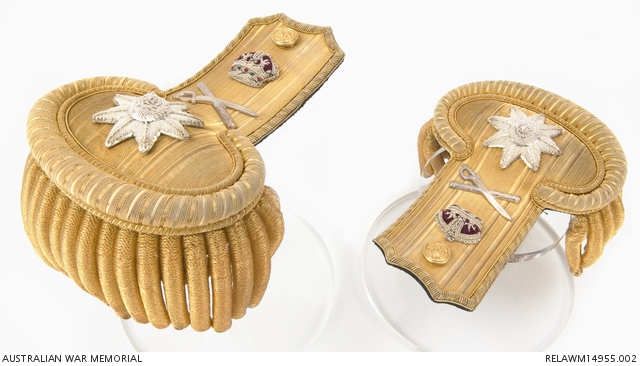| Place | Europe: United Kingdom |
|---|---|
| Accession Number | RELAWM14955.002 |
| Collection type | Heraldry |
| Object type | Uniform |
| Physical description | Gold bullion wire; Gold bullion lace; Gilded brass; Brass; Silk; Leather; Silver bullion; Silver |
| Maker |
Moore, Scantlebury & Coote |
| Place made | United Kingdom |
| Date made | c 1921 |
| Conflict |
Period 1920-1929 |
Pair full dress epaulettes : Rear Admiral J C T Glossop, Royal Navy

Pair of flag officer's full dress epaulettes lined with black leather stamped in gold with the manufacturer's details, and with padded blue silk where the epaulette rests on the end of the wearer's shoulder. Each epaulette has a brass slide underneath the strap and a gilded brass Royal Navy flag officer's button on top of the strap to secure it to the coat. The slides are stamped 'RIGHT' and 'LEFT'. The upper side of the epaulette straps are covered in plain gold lace with a raised gold wire embroidered crescent at the shoulder end. Each strap bears rank insignia for a Rear Admiral: a silver and velvet embroidered king's crown, a silver crossed sword and baton, and a large embroidered silver bullion eight-pointed star. The ends of the epaulettes have a double row of gold bullions. There are twenty gold bullions around the outer rim and nineteen smaller bullions inside them.
Worn by Rear Admiral John Collings Taswell Glossop, Royal Navy. Born in England in 1871, Glossop served as a midshipmen in Samoan waters in the corvette HMS Calliope, and as a lieutenent in the corvette HMS Royalist during the 'Samoan troubles' of 1899. His later service included a posting as commander in the battleship HMS Hood. In June 1911 Glossop was promoted to captain and on 26 June 1913 was lent to the Royal Australian Navy and appointed to command the newly commissioned Chatham class light cruiser HMAS Sydney. During the First World War the Sydney, under Glossop's command, defeated and beached the German raider SMS Emden off the Cocos-Keeling Islands on 9 November 1914. In 1915 the Sydney was sent to protect British colonies in the West Indies and in 1916 transferred to the North Sea, patrolling to intercept German merchant shipping and submarines. Glossop left the ship in the middle of 1917. He was promoted to Rear Admiral in 1921 shortly before being placed on the retired list, and to Vice Admiral in 1926. He died in 1934. The epaulettes show little sign of wear and Glossop is unlikely to have worn them while on the retired list.